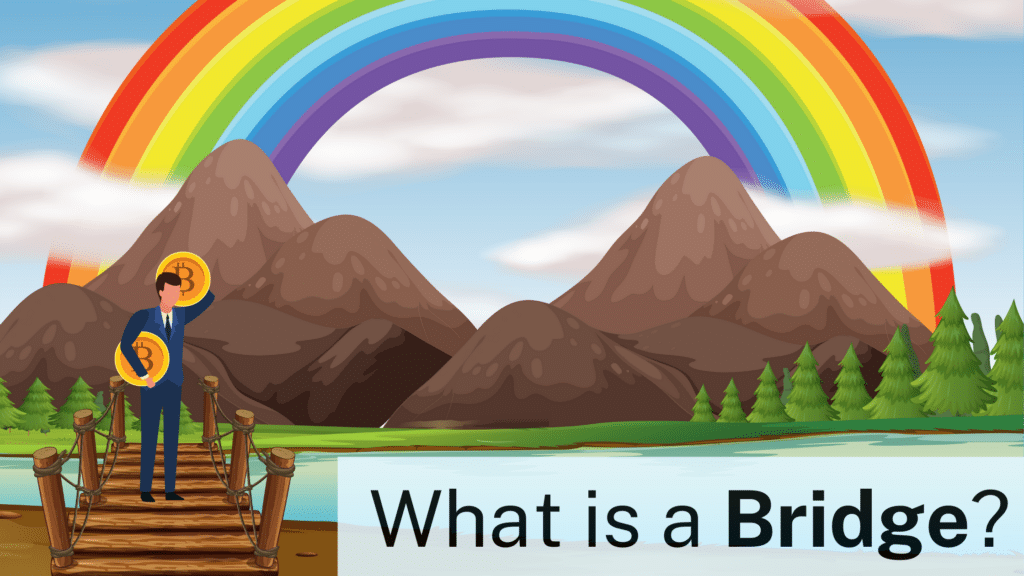What is a Blockchain Bridge?
A blockchain bridge is a software solution that allows different blockchain protocols to communicate.
The Long Definition
A blockchain bridge is a tool that connects two blockchain networks. By doing that, it facilitates communication between the protocols. This communication involves the transfer of information and assets. Depending on the networks and the technology, it can be one-way or two-way.
Blockchain bridges play a crucial role in decentralized finance (DeFi). As a result, many have been created. The different types of bridges available can be classified as trusted or trustless and one-way (unidirectional) or two-way (bidirectional).

Why are they important?
Blockchain technology forms the foundation of cryptocurrency. Today, there are many blockchains. Thus, there are many different cryptocurrencies.
Some blockchains, like Ethereum, Polygon, and BSC also have smart contract support. This has allowed their application to extend beyond crypto transactions. They support entire DeFi ecosystems, full of financial applications, products, and opportunities.
The Interoperability Problem
Each blockchain is built differently. It has its own development path, consensus mechanism, tokens, and rules. Basically, it exists as its own ecosystem, completely separate from the other. Therefore, two blockchain networks cannot natively communicate with one another.
This meant that for the longest time, there was no way to move assets between chains. So, you could not use a crypto coin in a blockchain other than its own. There was no interoperability. This was a big problem, especially for DeFi users.
For example, let’s say you hold bitcoin (BTC) that you want to use in DeFi trading. BTC is on the Bitcoin blockchain. However, this blockchain doesn’t have any DeFi applications due to its lack of smart contract support. Ethereum, on the other hand, has smart contracts. So, it has a lot of decentralized exchanges (DEXs).
Traditionally, you couldn’t access the opportunities available on Ethereum with your BTC. Your value was essentially locked in the Bitcoin network. The only way out is to sell your BTC and buy Ether (ETH) at a centralized exchange (CEX). This isn’t an attractive option for those who want to keep it DeFi.

Bridges to the Rescue
The blockchain bridge was created to solve this problem. They function as links between different blockchain ecosystems. Just like a physical bridge lets you move from one side to another, a crypto bridge allows assets and information to pass from one protocol to another. That way, DeFi users can move value across different blockchains. They have access to new platforms and opportunities across different chains.
In the example above, a bridge will allow you to move your BTC from Bitcoin to Ethereum. Once there, you can use it for decentralized trading, lending, staking, liquidity providing, etc.
And it’s not just the users that benefit from bridges– dApps and developers also benefit. Bridges expand the user base of dApps from a single chain to multiple ones. They also allow developers from different ecosystems to collaborate. They can leverage each others’ work to build new platforms and improve existing ones.
How Does a Blockchain Bridge Work?
A cross-chain bridge provides a path for blockchains to communicate with one another. That way, you can send information and tokens between networks. In this regard, a bridge can be;
- Bidirectional: It allows back-and-forth communication between blockchains. You can move information and assets from protocol A to B and vice-versa.
- Unidirectional: It only allows one-way communication. Information and assets can only flow from protocol A into B. This is how all Bitcoin-Ethereum bridges are.
When moving crypto from one chain to another, the bridge ‘wraps’ the asset. This involves converting it into a token supported by the target blockchain.

Let’s Break it Down:
In our example, bitcoin will be converted into an ERC-20 token. This token is known as Wrapped Bitcoin (WBTC). It is compatible with all kinds of dApps on the Ethereum blockchain.
Note that while they’re called wrapped assets, a wrapped token is not the actual token itself with a special wrapper. Instead, it is a representation of the asset on the target blockchain. It can be redeemed 1:1 for the real asset, which is what gives it value. Think of it as an IOU.
So when you bridge an asset, the bridge holds the real asset. In return, it issues you another token that then serves as a representation of the asset on the target blockchain.
In our example, the bridge takes the real BTC and issues you WBTC. WBTC is a representation of the BTC held by the bridge. When you bridge back, you trade in the WBTC for real BTC.
Generally, bridges are either trustless or trusted. Trustless means that they are decentralized. They completely rely on smart contracts and code to function. The user also retains control over their funds.
On the other hand, trusted bridges are centralized. They rely on a centralized authority to keep the bridge working. Here, the user needs to trust the bridge operator with their crypto assets.
Blockchain Bridges Example
Some popular cross-chain bridges include;
- Polygon Bridge: Supports the transfer of tokens from Ethereum to the Polygon sidechain. This is a layer-2 protocol on the Ethereum network.
- Arbitrum Bridge: Facilitates the transfer of tokens between the Ethereum and Avalanche networks.
- Binance Bridge: Lets users convert ERC-20 tokens into BSC-compatible tokens.
Want to join the Dypto journey? Follow our socials!